Evolution of Syngenite, K2Ca(SO4)2·H2O over a Wide Range of Temperatures and Pressures
Abstract
1. Introduction
2. Materials and Methods
2.1. Materials
2.2. Methods
3. Results
3.1. Syngenite Structure Refinement at −173 °C
3.2. Raman Spectroscopy
3.3. DSC and TGA Analysis
3.4. Low- and High-Temperature Powder X-Ray Diffraction
3.5. Thermal Expansion
3.6. Baric Compression
4. Concluding Remarks
Author Contributions
Funding
Data Availability Statement
Acknowledgments
Conflicts of Interest
References
- Spencer, R.J. Sulfate minerals in evaporite deposits. Rev. Mineral. Geochem. 2000, 40, 173–192. [Google Scholar] [CrossRef]
- Babel, M.; Schreiber, B.C. Geochemistry of evaporites and evolution of seawater. In Treatise on Geochemistry, 2nd ed.; Holland, H.D., Turekian, K.K., Eds.; Elsevier: Oxford, UK, 2014; Volume 3, pp. 483–560. [Google Scholar] [CrossRef]
- Pekov, I.V.; Kovrugin, V.M.; Siidra, O.I.; Chukanov, N.V.; Belakovskiy, D.I.; Koshlyakova, N.N.; Yapaskurt, V.O.; Turchkova, A.G.; Möhn, G. Antofagastaite, Na2Ca(SO4)2·1.5H2O, a new mineral related to syngenite. Mineral. Mag. 2019, 83, 781–790. [Google Scholar] [CrossRef]
- Snow, M.R.; Pring, A.; Allen, N. Minerals of the Wooltana Cave, Flinders Ranges, South Australia. Trans. R. Soc. S. Aust. 2014, 138, 214–230. [Google Scholar] [CrossRef]
- Vaniman, D.T.; Bish, D.L.; Ming, D.W.; Bristow, T.F.; Morris, R.V.; Blake, D.F.; Chipera, S.J.; Morrison, S.M.; Treiman, A.H.; Rampe, E.B.; et al. Mineralogy of a mudstone at Yellowknife Bay, Gale crater, Mars. Science 2014, 343, 1243480. [Google Scholar] [CrossRef] [PubMed]
- Wang, A.; Freeman, J.J.; Jolliff, B.L.; Chou, I.-M. Sulfates on Mars: A systematic Raman spectroscopic study of hydration states of magnesium sulfates. Geochim. Cosmochim. Acta 2006, 70, 6118–6135. [Google Scholar] [CrossRef]
- García-Florentino, C.; Gomez-Nubla, L.; Huidobro, J.; Torre-Fdez, I.; Ruíz-Galende, P.; Aramendia, J.; Hausrath, E.M.; Castro, K.; Arana, G.; Madariaga, J.M. Interrelationships in the gypsum-syngenite-gorgeyite system and their possible formation on Mars. Astrobiology 2021, 21, 332–344. [Google Scholar] [CrossRef]
- Comodi, P.; Nazzareni, S.; Zanazzi, P.F.; Speziale, S. High-pressure behavior of gypsum: A single-crystal X-ray study. Am. Mineral. 2008, 93, 1530–1537. [Google Scholar] [CrossRef]
- Bradbury, S.E.; Williams, Q. X-ray diffraction and infrared spectroscopy of monazite-structured CaSO4 at high pressures: Implications for shocked anhydrite. J. Phys. Chem. Solids 2009, 70, 134–141. [Google Scholar] [CrossRef]
- Neville, A. The confused world of sulfate attack on concrete. Cem. Concr. Res. 2004, 34, 1275–1296. [Google Scholar] [CrossRef]
- Smillie, S.; Moulin, E.; Glasser, F.P. Freshness of cement: Conditions for syngenite CaK2(SO4)2·H2O formation. Adv. Cem. Res. 1993, 5, 93–96. [Google Scholar] [CrossRef]
- Zhao, Y.; Hu, X.; Yuan, Q.; Shi, C. The change of phase assemblage and desorption of bound chloride for seawater cement paste under sulfate attack. Cem. Concr. Compos. 2023, 139, 105033. [Google Scholar] [CrossRef]
- Dankiewicz, J.; Wieczorek-Ciurowa, K. Kinetic study of the thermal dehydration of syngenite K2Ca(SO4)2·H2O under isothermal conditions. J. Therm. Anal. Calorim. 1978, 13, 543–552. [Google Scholar] [CrossRef]
- Dankiewicz, J.; Wieczorek-Ciurowa, K. Kinetic study of the thermal dehydration of syngenite K2Ca(SO4)2·H2O under non-isothermal conditions. J. Therm. Anal. Calorim. 1979, 15, 11–24. [Google Scholar] [CrossRef]
- Kloprogge, J.T.; Ding, Z.; Martens, W.N.; Schuiling, R.D.; Duongc, L.V.; Frost, R.L. Thermal decomposition of syngenite, K2Ca(SO4)2·H2O. Thermochim. Acta 2004, 417, 143–155. [Google Scholar] [CrossRef]
- Gorogotskaya, L.I. Crystal structure of singenite K2Ca[SO4]2·H2O. Dokl. Acad. Nauk. SSSR 1964, 157, 67–69. (In Russian) [Google Scholar]
- Corazza, E.; Sabelli, C. The crystal structure of syngenite, K2Ca(SO4)2·H2O. Z. Kristallogr. 1967, 124, 398–408. [Google Scholar] [CrossRef]
- Bokii, G.B.; Pal’chik, N.A.; Antipin, M.Y. The crystal structure of syngenite. Sov. Phys. Crystallogr. 1978, 23, 141–143. (In Russian) [Google Scholar]
- Ballirano, P.; Belardi, G.; Maras, A. Refinement of the structure of synthetic syngenite K2Ca(SO4)2·H2O from X-ray powder diffraction data. Neues Jahrb. Für Mineral. 2005, 182, 15–21. [Google Scholar] [CrossRef]
- Barlow, N. Mars: An Introduction to Its Interior, Surface and Atmosphere; CUP: Cambridge, UK, 2008; p. 286. [Google Scholar] [CrossRef]
- Rigaku OD. CrysAlisPro Software System, Version 1.171.41.103a; Rigaku Corporation: Oxford, UK, 2021.
- Sheldrick, G.M. Crystal structure refinement with SHELXL. Acta Cryst. C 2015, 71, 3–8. [Google Scholar] [CrossRef]
- Gagné, O.C.; Hawthorne, F.C. Comprehensive derivation of bond-valence parameters for ion pairs involving oxygen. Acta Crystallogr. B 2015, 71, 562–578. [Google Scholar] [CrossRef]
- Raschenko, S.V. Chrystchemlib: A Python library and GUI for analysis of crystal structure datasets. J. Appl. Crystallogr. 2025, 58, 290–295. [Google Scholar] [CrossRef]
- Downs, R.T. Analysis of harmonic displacement factors. In High-Temperature and High-Pressure Crystal Chemistry; Hazen, R.M., Downs, R.T., Eds.; De Gruyter: Berlin, Germany, 2000; Volume 41, pp. 61–87. [Google Scholar] [CrossRef]
- Rigaku OD. PDXL: Integrated X-Ray Powder Diffraction Software; Rigaku Corporation: Oxford, UK, 2016. [Google Scholar]
- Bruker AXS. Topas V5.0; Bruker AXS: Karlsruhe, Germany, 2014. [Google Scholar]
- Bubnova, R.S.; Firsova, V.A.; Volkov, S.N.; Filatov, S.K. RietveldToTensor: Program for Processing Powder X-Ray Diffraction Data Under Variable Conditions. Glass Phys. Chem. 2018, 44, 33–40. [Google Scholar] [CrossRef]
- Prescher, C.; Prakapenka, V.B. DIOPTAS: A program for reduction of two-dimensional X-ray diffraction data and data exploration. High Press. Res. 2015, 35, 223–230. [Google Scholar] [CrossRef]
- Klotz, S.; Chervin, J.-C.; Munsch, P.; Le Marchand, G. Hydrostatic limits of 11 pressure transmitting media. J. Phys. D Appl. Phys. 2009, 42, 075413. [Google Scholar] [CrossRef]
- Dewaele, A.; Torrent, M.; Loubeyre, P.; Mezouar, M. Compression curves of transition metals in the Mbar range: Experiments and projector augmented-wave calculations. Phys. Rev. B 2008, 78, 104102. [Google Scholar] [CrossRef]
- Bubnova, R.S.; Firsova, V.A.; Filatov, S.K. Software for determining the thermal expansion tensor and the graphic representation of its characteristic surface (theta to tensor-TTT). Glass Phys. Chem. 2013, 39, 347–350. [Google Scholar] [CrossRef]
- Kloprogge, J.T.; Schuiling, R.D.; Ding, Z.; Hickey, L.; Wharton, D.; Frost, R.L. Vibrational spectroscopic study of syngenite formed during the treatment of liquid manure with sulphuric acid. Vib. Spectrosc. 2002, 28, 209–221. [Google Scholar] [CrossRef]
- Buzgar, N.; Buzatu, A.; Sanislav, I.V. The Raman study on certain sulfates. Analele Ştiinţifice Ale Univ. 2009, 55, 5–23. [Google Scholar]
- Speer, D.; Salje, E. Phase transitions in langbeinites. I. Crystal chemistry and structures of K-double sulfates of the langbeinite type M2K2(SO4)3, M = Mg, Ni, Co, Zn, Ca. Phys. Chem. Miner. 1986, 13, 1724. [Google Scholar] [CrossRef]
- Arnold, H.; Kurtz, W.; Richter-Zinnius, A.; Bethke, J.; Heger, G. The phase transition of K2SO4 at about 850 K. Acta Crystallogr. B 1981, 37, 1643–1651. [Google Scholar] [CrossRef]
- Van den Berg, A.J.; Tuinstra, F. The space group and structure of α-K2SO4. Acta Crystallogr. B 1978, 34, 3177–3181. [Google Scholar] [CrossRef]
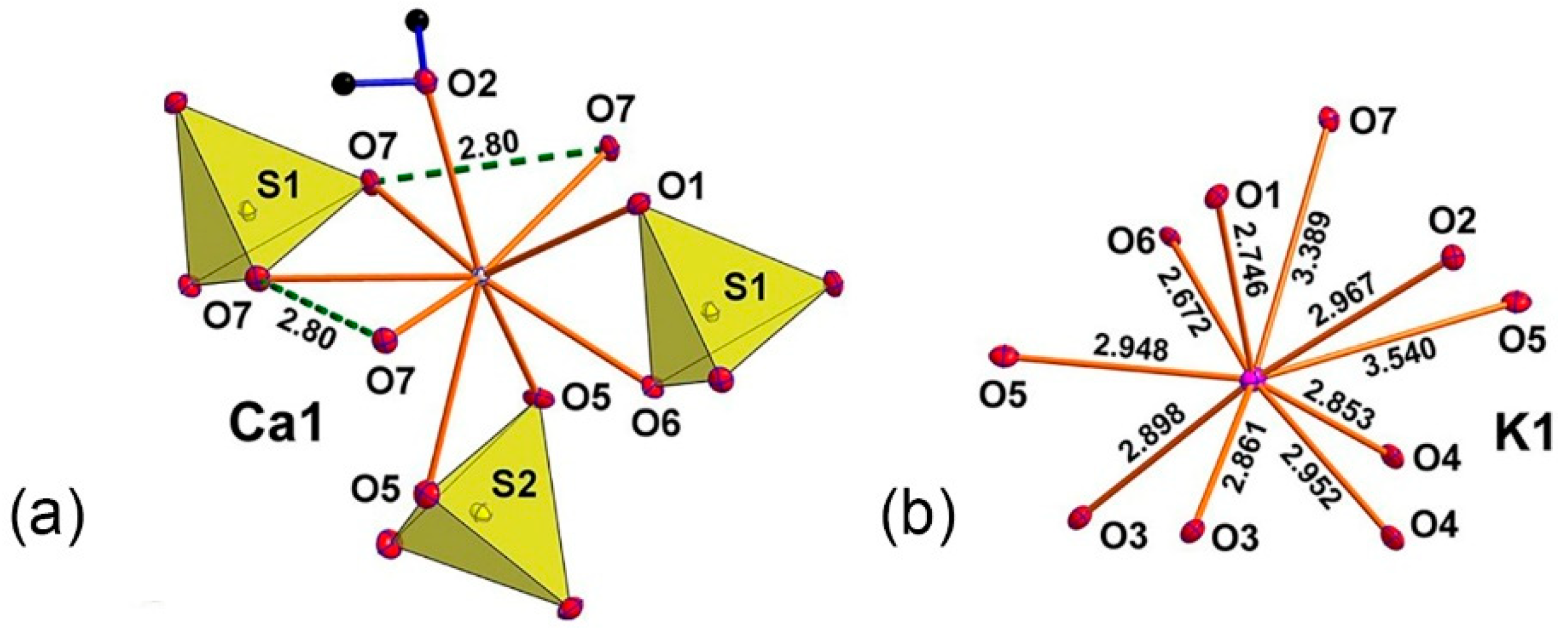
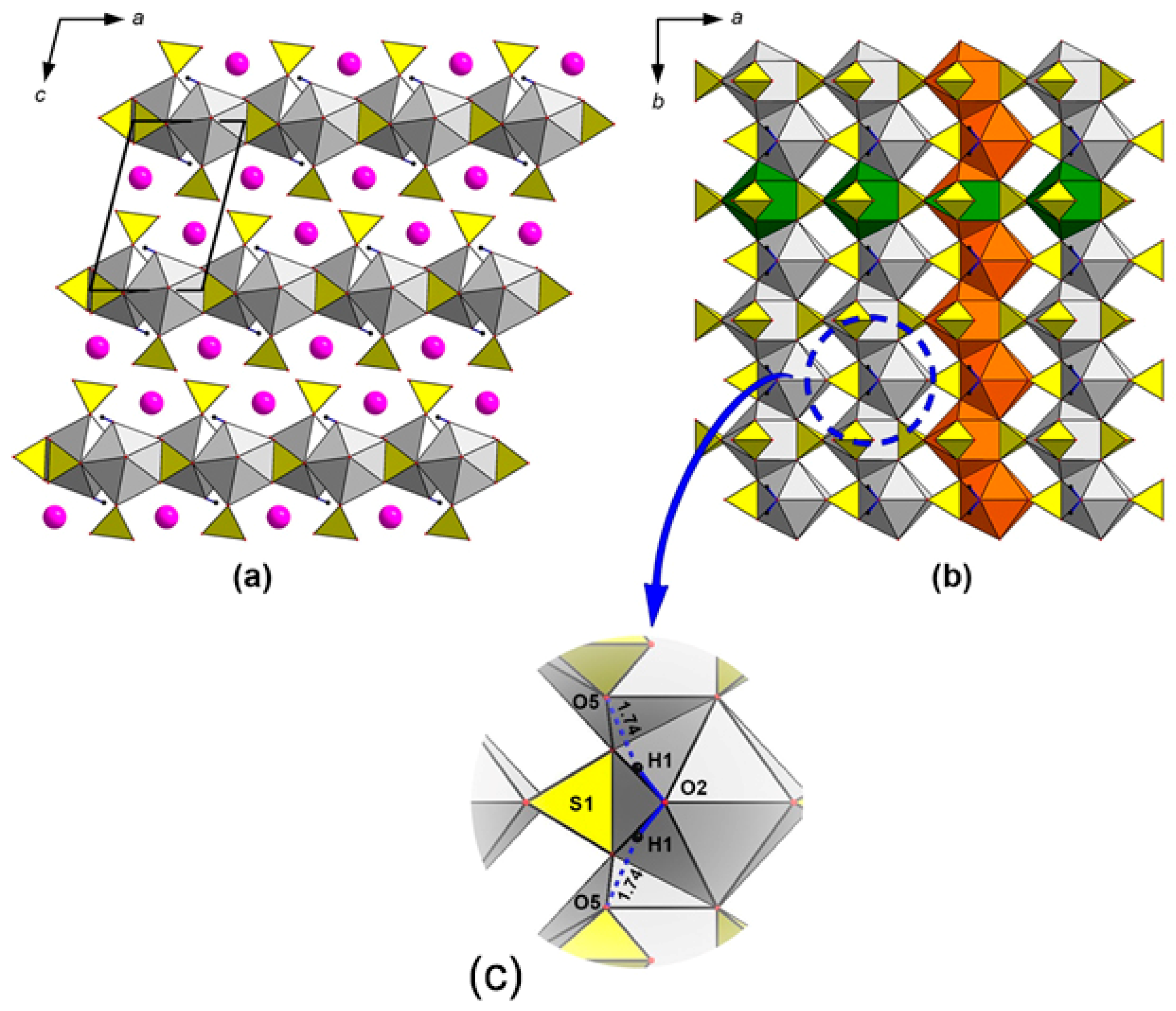




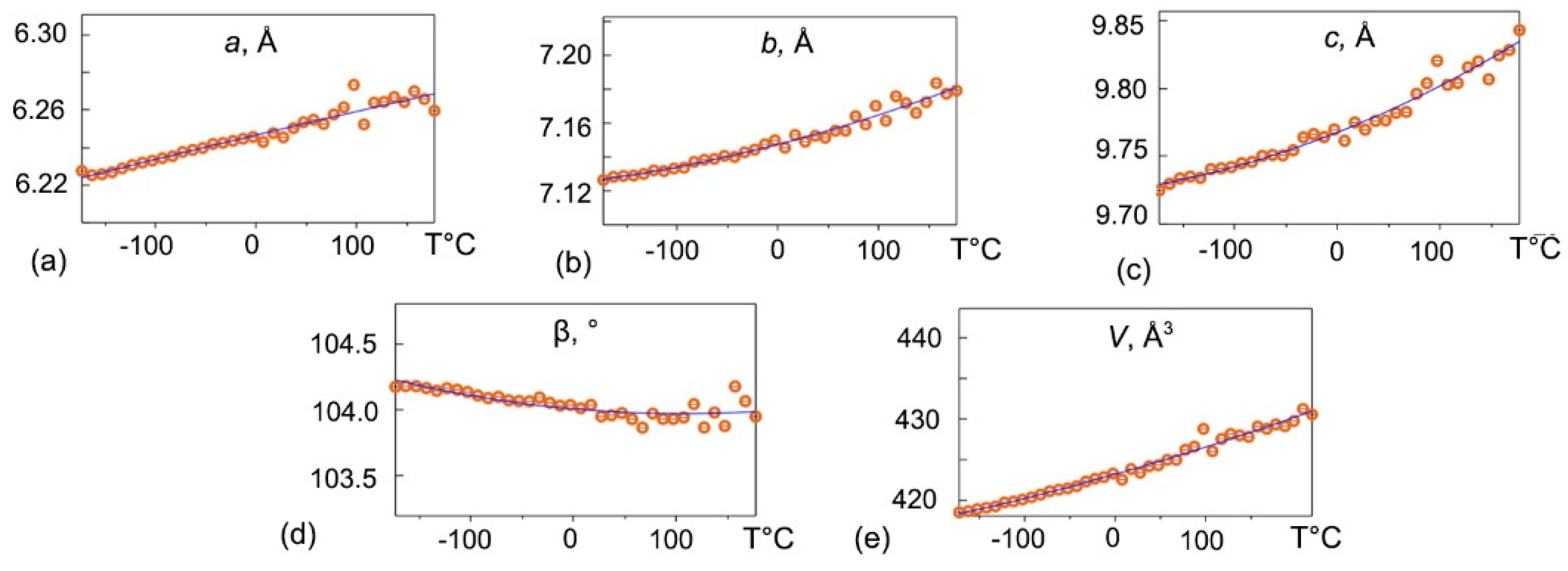
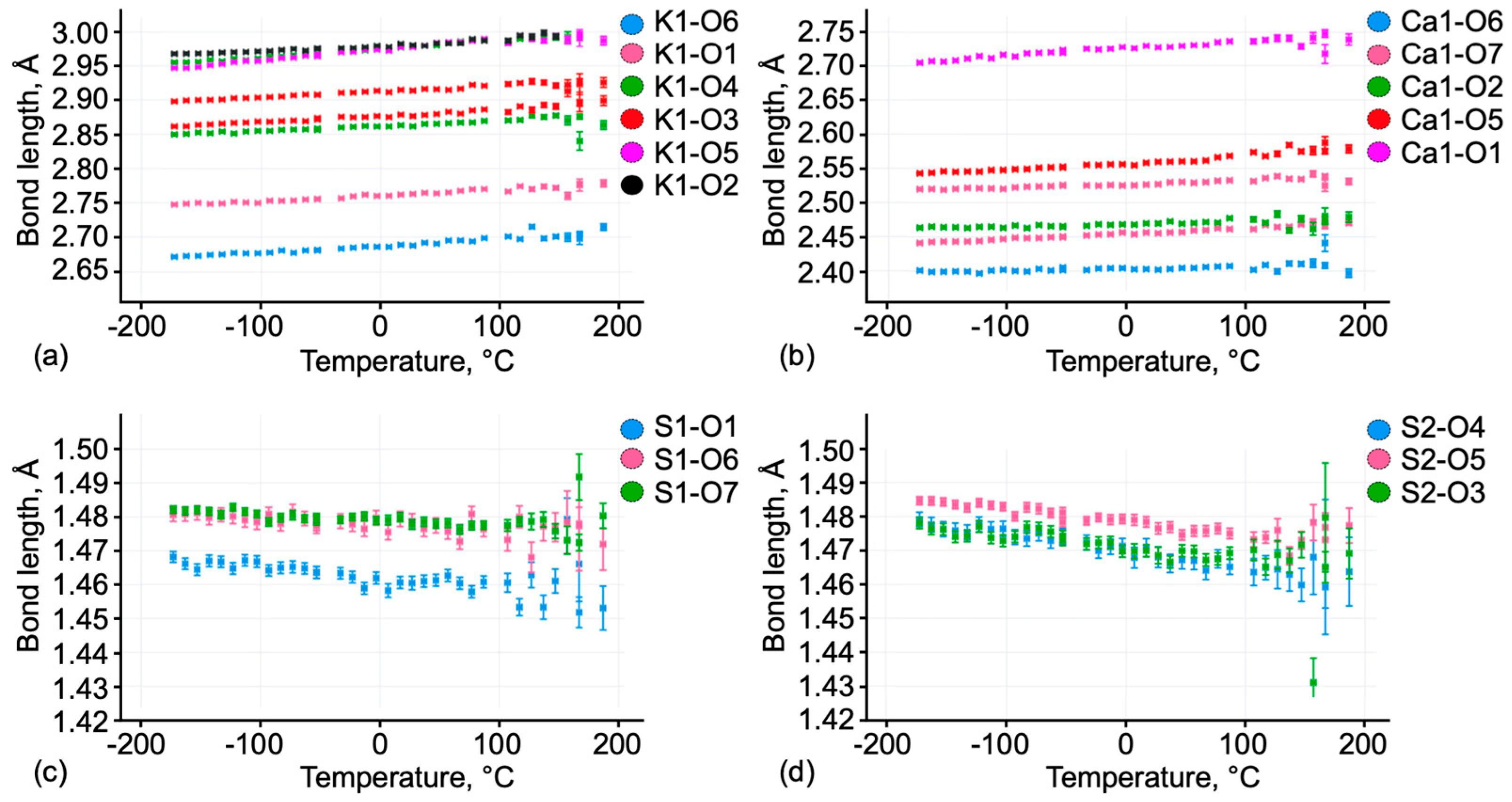
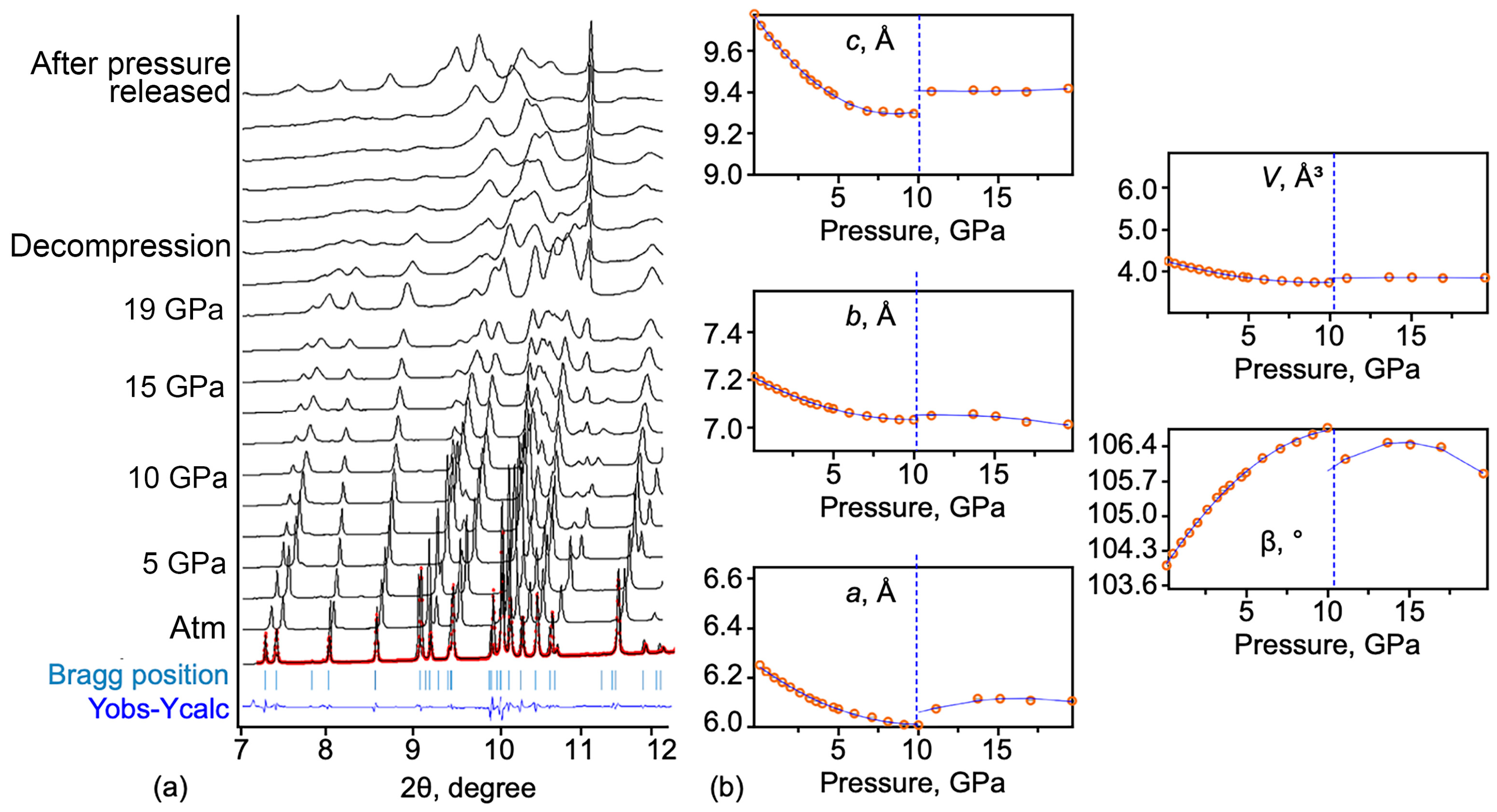

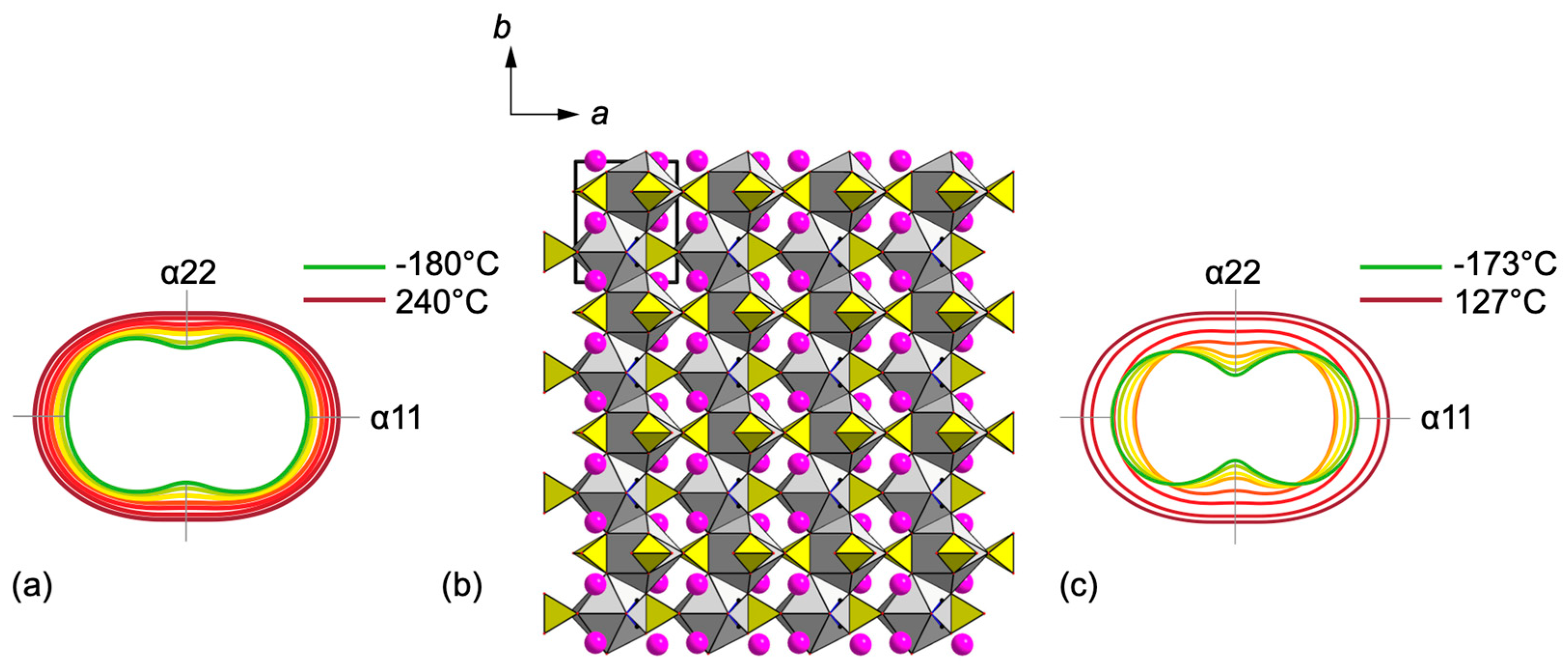
| Crystal data: | |
| Temperature | −173 °C |
| Radiation | MoKα, 0.71073 Å |
| Crystal system | monoclinic |
| Space group | P21/m |
| a (Å) | 6.2276(2) |
| b (Å) | 7.1264(2) |
| c (Å) | 9.7249(3) |
| β (°) | 104.174(3) |
| Volume (Å3)/Z | 418.46(2)/2 |
| Dcalc (g/cm3) | 2.606 |
| μ (mm−1) | 2.269 |
| Crystal size (mm) | 0.05 × 0.05 × 0.03 |
| Data collection: | |
| θ range (°) | 3.374–27.995 |
| h, k, l ranges | −8 → 8, −8 → 9, −12 → 12 |
| Total reflections collected | 4733 |
| Unique reflections (Rint) | 1091 (0.0259) |
| Unique reflections F > 4σF | 1050 |
| Structure refinement: | |
| Weighting scheme a, b | 0.0287, 0.2531 |
| R1[F > 4σF], wR2[F > 4σF] | 0.0200, 0.0525 |
| R1 all, wR2 all | 0.0209, 0.0533 |
| Goodness-of-fit | 1.068 |
| Largest diff. peak and hole, e Å−3 | 0.358, −0.525 |
| Bond | Length | Bond | Length | Bond | Length |
|---|---|---|---|---|---|
| Ca1–O6 | 2.4008(16) | K1–O6 | 2.6712(12) | S1–O1 | 1.4684(16) |
| –O7 | 2.4409(10) | –O1 | 2.7474(13) | –O6 | 1.4806(15) |
| –O7 | 2.4409(10) | –O4 | 2.8496(13) | –O7 | 1.4821(10) |
| –O2 | 2.4632(17) | –O3 | 2.8612(13) | –O7 | 1.4821(10) |
| –O7 | 2.5196(11) | –O3 | 2.8980(12) | <S1–O> | 1.478 |
| –O7 | 2.5196(11) | –O5 | 2.9466(11) | S2–O3 | 1.4779(17) |
| –O5 | 2.5428(12) | –O4 | 2.9547(14) | –O4 | 1.4791(15) |
| –O5 | 2.5428(12) | –O2 | 2.9674(12) | –O5 | 1.4846(11) |
| –O1 | 2.7040(16) | –O7 | 3.3885(11) | –O5 | 1.4846(11) |
| –O5 | 3.5406(11) | ||||
| <Ca–O> | 2.508 | <K–O> | 2.921 | <S2–O> | 1.482 |
| O1 | O2 | O3 | O4 | O5 | O6 | O7 | ∑→ | |
|---|---|---|---|---|---|---|---|---|
| Ca1 | 0.14 | 0.26 | 0.21 × 2 → | 0.30 | 0.27 × 2 → 0.22 × 2 → | 2.10 | ||
| K1 | 0.17 | 0.10 | 0.13 0.12 | 0.13 0.10 | 0.10 0.02 | 0.21 | 0.03 | 1.12 |
| S1 | 1.52 | 1.47 | 1.47 × 2 → | 5.93 | ||||
| S2 | 1.48 | 1.48 | 1.46 × 2 → | 5.88 | ||||
| H1 | 0.78 | 0.22 | 1.00 | |||||
| ∑↓ | 1.84 | 1.14 | 1.73 | 1.71 | 2.02 | 1.98 | 1.98 |
| Site | x | y | z | Ueq |
|---|---|---|---|---|
| Ca1 | 0.33229(7) | ¼ | 0.96804(4) | 0.00475(11) |
| K1 | 0.19574(5) | 0.00708(4) | 0.33628(3) | 0.00840(10) |
| S1 | 0.83905(8) | ¼ | 0.98918(5) | 0.00423(12) |
| S2 | 0.26602(8) | ¼ | 0.63740(6) | 0.00529(12) |
| O1 | 0.0200(3) | ¼ | 0.11840(17) | 0.0081(3) |
| O2 | 0.5016(3) | ¼ | 0.22504(17) | 0.0083(3) |
| O3 | 0.0518(3) | ¼ | 0.53026(17) | 0.0089(3) |
| O4 | 0.4494(3) | ¼ | 0.56531(18) | 0.0103(3) |
| O5 | 0.28027(18) | 0.08345(15) | 0.73091(12) | 0.0091(2) |
| O6 | 0.9400(3) | ¼ | 0.86626(17) | 0.0070(3) |
| O7 | 0.69383(17) | 0.08360(14) | 0.98150(11) | 0.0071(2) |
| H1 | 0.608(3) | 0.144(2) | 0.252(3) | 0.041(7) |
| This Work | Kloprogge et al., 2002 [33] | Buzgar et al., 2009 [34] | |
|---|---|---|---|
| 183 | 240 | T (M, H2O) | |
| 424 | ν2 (SO4) | ||
| 442 | 441 | 442 | |
| 478 | 471 | 477 | |
| 492 | 491 | 495 | |
| 632 | ν4 (SO4) | ||
| 641 | 641 | 641 | |
| 660 | 663 | ||
| 981 | 981 | 982 | ν1 (SO4) |
| 1006 | 1004 | 1006 | |
| 1099 | 1084 | ν3 (SO4) | |
| 1117 | 1120 | ||
| 1138 | 1138 | 1143 | |
| 1169 | 1166 | 1167 | |
| 3319 | 3305 | ν (H2O) |
| T | α11 | α22 | α33 | αa | αb | αc | αβ | αV |
|---|---|---|---|---|---|---|---|---|
| −180 | 37.36(59) | 16.99(27) | 17.23(27) | 25.73(53) | 16.99(37) | 23.94(13) | −10.69(21) | 71.6(1.1) |
| −150 | 37.21(50) | 17.64(24) | 17.93(24) | 26.54(46) | 17.64(32) | 23.92(13) | −10.18(18) | 72.78(99) |
| −120 | 37.09(42) | 18.28(21) | 18.61(21) | 27.36(39) | 18.28(28) | 23.90(13) | −9.67(16) | 73.97(84) |
| −90 | 36.99(34) | 18.93(17) | 19.25(18) | 28.17(32) | 18.93(23) | 23.89(13) | −9.17(13) | 75.17(69) |
| −60 | 36.92(26) | 19.57(14) | 19.87(14) | 28.97(26) | 19.57(18) | 23.87(13) | −8.66(10) | 76.36(55) |
| −30 | 36.89(20) | 20.21(11) | 20.45(11) | 29.78(20) | 20.21(14) | 23.85(13) | −8.154(79) | 77.55(43) |
| 0 | 36.90(15) | 20.853(87) | 20.988(87) | 30.58(15) | 20.85(11) | 23.84(13) | −7.647(61) | 78.74(33) |
| 30 | 36.95(14) | 21.493(78) | 21.485(78) | 31.38(14) | 21.493(96) | 23.82(13) | −7.139(54) | 79.93(29) |
| 60 | 37.05(15) | 22.131(91) | 21.934(90) | 32.18(15) | 22.13(11) | 23.80(13) | −6.631(62) | 81.11(34) |
| 90 | 37.19(20) | 22.77(12) | 22.33(12) | 32.98(20) | 22.77(14) | 23.78(13) | −6.123(81) | 82.30(43) |
| 120 | 37.39(25) | 23.40(16) | 22.68(15) | 33.77(25) | 23.40(18) | 23.77(13) | −5.61(11) | 83.48(55) |
| 150 | 37.64(31) | 24.04(20) | 22.97(19) | 34.56(32) | 24.04(23) | 23.75(13) | −5.11(13) | 84.65(69) |
| 180 | 37.94(37) | 24.67(24) | 23.21(23) | 35.35(38) | 24.67(27) | 23.75(13) | −5.11(13) | 84.65(69) |
| 210 | 38.30(43) | 25.30(29) | 23.39(26) | 36.14(45) | 25.30(32) | 23.72(13) | −4.09(19) | 87.00(97) |
| 240 | 38.70(50) | 25.93(33) | 23.53(30) | 36.92(52) | 25.93(37) | 23.70(13) | −3.58(22) | 88.2(1.1) |
| T | α11 | α22 | α33 | αa | αb | αc | αβ | αV |
|---|---|---|---|---|---|---|---|---|
| −173 | 41.1(4.4) | 16.0(1.7) | 6.72(73) | 25.5(4) | 16.0(2.4) | 14.4(3.1) | −23.4(4) | 63.9(6.9) |
| −153 | 39.9(3.8) | 16.6(1.5) | 8.56(82) | 24.8(3.6) | 16.6(2.1) | 16.3(2.8) | −22.2(3.7) | 65.1(6.2) |
| −133 | 38.8(3.2) | 17.2(1.4) | 10.34(87) | 24.1(3.2) | 17.2(1.9) | 18.2(2.5) | −21.0(3.5) | 66.3(5.6) |
| −113 | 37.8(2.7) | 17.7(1.3) | 12.04(88) | 23.5(2.8) | 17.7(1.7) | 20.1(2.2) | −19.7(3.2) | 67.5(4.9) |
| −93 | 36.8(2.3) | 18.3(1.1) | 13.63(86) | 22.8(2.5) | 18.3(1.5) | 22.0(1.9) | −18.5(2.9) | 68.8(4.3) |
| −73 | 36.1(1.9) | 18.8(1) | 15.08(80) | 22.1(2.1) | 18.8(1.3) | 23.9(1.6) | −17.3(2.7) | 70.0(3.7) |
| −53 | 35.5(1.5) | 19.41(86) | 16.34(72) | 21.5(1.8) | 19.4(1.1) | 25.8(1.4) | −16.1(2.4) | 71.2(3.1) |
| −33 | 17.34(63) | 19.97(72) | 35.1(1.2) | 20.8(1.5) | 19.97(92) | 27.7(1.1) | −14.8(2.2) | 72.4(2.6) |
| −13 | 18.03(53) | 20.53(61) | 35.1(1) | 20.1(1.2) | 20.53(76) | 29.63(99) | −13.6(1.9) | 73.7(2.1) |
| 7 | 18.37(46) | 21.09(53) | 35.42(89) | 19.4(1) | 21.09(66) | 31.52(85) | −12.4(1.7) | 74.9(1.8) |
| 27 | 18.36(43) | 21.65(51) | 36.10(85) | 18.8(1) | 21.65(63) | 33.41(81) | −11.2(1.4) | 76.1(1.7) |
| 47 | 18.03(45) | 22.21(56) | 37.08(93) | 18.1(1.1) | 22.21(68) | 35.30(88) | −9.9(1.2) | 77.3(1.9) |
| 67 | 17.45(51) | 22.76(66) | 38.3(1.1) | 17.5(1.3) | 22.76(80) | 37.2(1) | −8.7(1) | 78.5(2.2) |
| 87 | 16.68(57) | 23.32(80) | 39.7(1.3) | 16.8(1.6) | 23.32(97) | 39.1(1.2) | −7.46(87) | 79.7(2.7) |
| 107 | 15.76(64) | 23.88(97) | 41.3(1.6) | 16.1(1.9) | 23.9(1.1) | 40.9(1.4) | −6.23(75) | 81.0(3.2) |
| 127 | 14.74(69) | 24.4(1.1) | 43.0(2) | 15.5(2.2) | 24.4(1.3) | 42.8(1.7) | −5.00(71) | 82.2(3.8) |
| 147 | 13.64(73) | 25.0(1.3) | 44.7(2.3) | 14.8(2.6) | 25.0(1.5) | 44.7(2) | −3.76(78) | 83.4(4.4) |
| 167 | 12.48(74) | 25.5(1.5) | 46.5(2.7) | 14.1(2.9) | 25.5(1.7) | 46.5(2.3) | −2.53(92) | 84.5(5) |
| P | α11 | α22 | α33 | αa | αb | αc | αβ | αV |
|---|---|---|---|---|---|---|---|---|
| 0.1 | −5617(103) | −5178(95) | −15,276(280) | −7477(207) | −5178(93) | −11,283(182) | 4719(92) | −26,071(465) |
| 5 | −7718(83) | −2589(28) | −2599(28) | −3891(59) | −2589(26) | −5065(52) | 2587(25) | −12,907(140) |
| 10 | −417(127) | −101(31) | 1670(509) | −89(225) | 101(100) | 1642(202) | 536(91) | 1355(577) |
| 15 | −25(2708) | −667(2489) | 97(362) | 645(243) | −667(210) | 101(109) | −139(65) | 156(573) |
Disclaimer/Publisher’s Note: The statements, opinions and data contained in all publications are solely those of the individual author(s) and contributor(s) and not of MDPI and/or the editor(s). MDPI and/or the editor(s) disclaim responsibility for any injury to people or property resulting from any ideas, methods, instructions or products referred to in the content. |
© 2025 by the authors. Licensee MDPI, Basel, Switzerland. This article is an open access article distributed under the terms and conditions of the Creative Commons Attribution (CC BY) license (https://creativecommons.org/licenses/by/4.0/).
Share and Cite
Baikina, A.; Zadoya, A.; Borisov, A.; Alabarse, F.; Holzheid, A.; Ugolkov, V.; Siidra, O. Evolution of Syngenite, K2Ca(SO4)2·H2O over a Wide Range of Temperatures and Pressures. Crystals 2025, 15, 334. https://doi.org/10.3390/cryst15040334
Baikina A, Zadoya A, Borisov A, Alabarse F, Holzheid A, Ugolkov V, Siidra O. Evolution of Syngenite, K2Ca(SO4)2·H2O over a Wide Range of Temperatures and Pressures. Crystals. 2025; 15(4):334. https://doi.org/10.3390/cryst15040334
Chicago/Turabian StyleBaikina, Anna, Anastasiya Zadoya, Artem Borisov, Frederico Alabarse, Astrid Holzheid, Valery Ugolkov, and Oleg Siidra. 2025. "Evolution of Syngenite, K2Ca(SO4)2·H2O over a Wide Range of Temperatures and Pressures" Crystals 15, no. 4: 334. https://doi.org/10.3390/cryst15040334
APA StyleBaikina, A., Zadoya, A., Borisov, A., Alabarse, F., Holzheid, A., Ugolkov, V., & Siidra, O. (2025). Evolution of Syngenite, K2Ca(SO4)2·H2O over a Wide Range of Temperatures and Pressures. Crystals, 15(4), 334. https://doi.org/10.3390/cryst15040334








